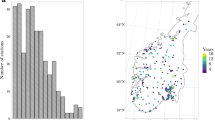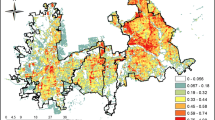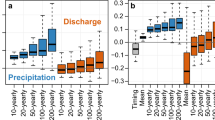Abstract
The hazard of pluvial flooding is largely influenced by the spatial and temporal dependence characteristics of precipitation. When extreme precipitation possesses strong spatial dependence, the risk of flooding is amplified due to catchment factors such as topography that cause runoff accumulation. Temporal dependence can also increase flood risk as storm water drainage systems operating at capacity can be overwhelmed by heavy precipitation occurring over multiple days. While transformed Gaussian processes are common choices for modeling precipitation, their weak tail dependence may lead to underestimation of flood risk. Extreme value models such as the generalized Pareto processes for threshold exceedances and max-stable models are attractive alternatives, but are difficult to fit when the number of observation sites is large, and are of little use for modeling the bulk of the distribution, which may also be of interest to water management planners. While the atmospheric dynamics governing precipitation are complex and difficult to fully incorporate into a parsimonious statistical model, non-mechanistic analogue methods that approximate those dynamics have proven to be promising approaches to capturing the temporal dependence of precipitation. In this paper, we present a Bayesian analogue method that leverages large, synoptic-scale atmospheric patterns to make precipitation forecasts. Changing spatial dependence across varying intensities is modeled as a mixture of spatial Student-t processes that can accommodate both strong and weak tail dependence. The proposed model demonstrates improved performance at capturing the distribution of extreme precipitation over Community Atmosphere Model (CAM) 5.2 forecasts.
Supplementary materials accompanying this paper appear online.





Similar content being viewed by others
References
Ailliot, P., D. Allard, V. Monbet, and P. Naveau (2015). Stochastic weather generators: an overview of weather type models. Journal de la Société Française de Statistique 156(1), 101–113.
Ailliot, P., C. Thompson, and P. Thomson (2009). Space–time modelling of precipitation by using a hidden Markov model and censored Gaussian distributions. Journal of the Royal Statistical Society: Series C (Applied Statistics) 58(3), 405–426.
Albert, J. H. and S. Chib (1993). Bayesian analysis of binary and polychotomous response data. Journal of the American statistical Association 88(422), 669–679.
Bárdossy, A. and G. Pegram (2009). Copula based multisite model for daily precipitation simulation. Hydrology and Earth System Sciences 13(12), 2299–2314.
Bardossy, A. and E. J. Plate (1992). Space-time model for daily rainfall using atmospheric circulation patterns. Water Resources Research 28(5), 1247–1259.
Barnett, T. and R. Preisendorfer (1978). Multifield analog prediction of short-term climate fluctuations using a climate state vector. Journal of the Atmospheric Sciences 35(10), 1771–1787.
Belkin, M. and P. Niyogi (2002). Laplacian eigenmaps and spectral techniques for embedding and clustering. In Advances in neural information processing systems, pp. 585–591.
Bellone, E., J. P. Hughes, and P. Guttorp (2000). A hidden Markov model for downscaling synoptic atmospheric patterns to precipitation amounts. Climate research 15(1), 1–12.
Berrocal, V. J., A. E. Raftery, and T. Gneiting (2008). Probabilistic quantitative precipitation field forecasting using a two-stage spatial model. The Annals of Applied Statistics 2(4), 1170–1193.
Boé, J., L. Terray, F. Habets, and E. Martin (2006). A simple statistical-dynamical downscaling scheme based on weather types and conditional resampling. Journal of Geophysical Research: Atmospheres 111(D23106).
Coifman, R. R. and S. Lafon (2006). Diffusion maps. Applied and computational harmonic analysis 21(1), 5–30.
Collett, D. (2002). Modelling binary data. CRC press, Boca Raton, FL.
Cooley, D., P. Naveau, and P. Poncet (2006). Variograms for spatial max-stable random fields. In Dependence in probability and statistics, pp. 373–390. Springer.
Cooley, D., D. Nychka, and P. Naveau (2007). Bayesian spatial modeling of extreme precipitation return levels. Journal of the American Statistical Association 102(479), 824–840.
Davison, A. C., S. A. Padoan, and M. Ribatet (2012). Statistical modeling of spatial extremes. Statistical Science. A Review Journal of the Institute of Mathematical Statistics 27(2), 161–186.
De Oliveira, V. (2000). Bayesian prediction of clipped Gaussian random fields. Computational Statistics & Data Analysis 34(3), 299–314.
De Oliveira, V. (2020). Models for Geostatistical Binary Data: Properties and Connections. Amer. Statist. 74(1), 72–79.
Delle Monache, L., I. Djalalova, and J. Wilczak (2014). Analog-based postprocessing methods for air quality forecasting. In Air Pollution Modeling and its Application XXIII, pp. 237–239. Springer.
Demsar, U., P. Harris, C. Brunsdon, A. S. Fotheringham, and S. McLoone (2013). Principal component analysis on spatial data: an overview. Annals of the Association of American Geographers 103(1), 106–128.
Ferreira, A. and L. De Haan (2014). The generalized Pareto process; with a view towards application and simulation. Bernoulli 20(4), 1717–1737.
Flecher, C., P. Naveau, D. Allard, and N. Brisson (2010). A stochastic daily weather generator for skewed data. Water Resources Research 46(7).
Fuentes, M., J. Henry, and B. Reich (2013). Nonparametric spatial models for extremes: Application to extreme temperature data. Extremes 16(1), 75–101.
Gao, X. and C. A. Schlosser (2019). Mid-western us heavy summer-precipitation in regional and global climate models: the impact on model skill and consensus through an analogue lens. Climate Dynamics 52(3), 1569–1582.
Gao, X., C. A. Schlosser, P. Xie, E. Monier, and D. Entekhabi (2014). An analogue approach to identify heavy precipitation events: Evaluation and application to CMIP5 climate models in the United States. Journal of Climate 27(15), 5941–5963.
Gelaro, R., W. McCarty, M. J. Suárez, R. Todling, A. Molod, L. Takacs, C. A. Randles, A. Darmenov, M. G. Bosilovich, and R. Reichle (2017). The modern-era retrospective analysis for research and applications, version 2 (MERRA-2). Journal of Climate 30(14), 5419–5454.
Gelfand, A. E., A. Kottas, and S. N. MacEachern (2005). Bayesian nonparametric spatial modeling with Dirichlet process mixing. Journal of the American Statistical Association 100(471), 1021–1035.
Gneiting, T. and M. Katzfuss (2014). Probabilistic forecasting. Annual Review of Statistics and Its Application 1, 125–151.
Hannachi, A., I. Jolliffe, and D. Stephenson (2007). Empirical orthogonal functions and related techniques in atmospheric science: A review. International journal of climatology 27(9), 1119–1152.
Hazra, A., B. J. Reich, B. A. Shaby, and A.-M. Staicu (2018). A semiparametric Bayesian model for spatiotemporal extremes. arXiv preprint arXiv:1812.11699.
Heagerty, P. J. and S. R. Lele (1998). A composite likelihood approach to binary spatial data. Journal of the American Statistical Association 93(443), 1099–1111.
Jolliffe, I. T. (2002). Principal component analysis (Second ed.). Springer Series in Statistics. Springer-Verlag, New York.
Kleiber, W., R. W. Katz, and B. Rajagopalan (2012). Daily spatiotemporal precipitation simulation using latent and transformed Gaussian processes. Water Resources Research 48(1).
Kohonen, T. (1984). Self-organization and associative memory, Volume 8 of Springer Series in Information Sciences. Springer-Verlag, Berlin.
Krick, I. P. (1942). A Dynamical Theory of the Atmospheric Circulation and Its Use in Weather Forecasting: Studies of Persistent Regularities in Weather Phenomena. California Institute of Technology.
Lguensat, R., P. Tandeo, P. Ailliot, M. Pulido, and R. Fablet (2017). The analog data assimilation. Monthly Weather Review 145(10), 4093–4107.
Liu, X., V. Gopal, and J. Kalagnanam (2018). A spatio-temporal modeling framework for weather radar image data in tropical southeast Asia. The Annals of Applied Statistics 12(1), 378–407.
Lorenz, E. N. (1969). Atmospheric predictability as revealed by naturally occurring analogues. Journal of the Atmospheric sciences 26(4), 636–646.
Luce, R. D. (1959). Individual choice behavior: A theoretical analysis. Courier Corporation.
Makhnin, O. V. and D. L. McAllister (2009). Stochastic precipitation generation based on a multivariate autoregression model. Journal of Hydrometeorology 10(6), 1397–1413.
Maraun, D., F. Wetterhall, A. Ireson, R. Chandler, E. Kendon, M. Widmann, S. Brienen, H. Rust, T. Sauter, and M. Themeßl (2010). Precipitation downscaling under climate change: Recent developments to bridge the gap between dynamical models and the end user. Reviews of Geophysics 48(3).
McDermott, P. L. and C. K. Wikle (2016). A model-based approach for analog spatio-temporal dynamic forecasting. Environmetrics 27(2), 70–82.
McDermott, P. L., C. K. Wikle, and J. Millspaugh (2018). A hierarchical spatiotemporal analog forecasting model for count data. Ecology and evolution 8(1), 790–800.
McFadden, D. (1973). Conditional logit analysis of qualitative choice behavior.
Morris, S. A., B. J. Reich, E. Thibaud, and D. Cooley (2017). A space-time skew-t model for threshold exceedances. Biometrics 73(3), 749.
Nagarajan, B., L. Delle Monache, J. P. Hacker, D. L. Rife, K. Searight, J. C. Knievel, and T. N. Nipen (2015). An evaluation of analog-based postprocessing methods across several variables and forecast models. Weather and Forecasting 30(6), 1623–1643.
Naveau, P., R. Huser, P. Ribereau, and A. Hannart (2016). Modeling jointly low, moderate, and heavy rainfall intensities without a threshold selection. Water Resources Research 52(4), 2753–2769.
Nikoloulopoulos, A. K., H. Joe, and H. Li (2009). Extreme value properties of multivariate t copulas. Extremes 12(2), 129–148.
Rasmussen, P. (2013). Multisite precipitation generation using a latent autoregressive model. Water Resources Research 49(4), 1845–1857.
Raziei, T., A. Mofidi, J. A. Santos, and I. Bordi (2012). Spatial patterns and regimes of daily precipitation in Iran in relation to large-scale atmospheric circulation. International Journal of Climatology 32(8), 1226–1237.
Reich, B. J. and B. A. Shaby (2012). A hierarchical max-stable spatial model for extreme precipitation. The Annals of Applied Statistics 6(4), 1430–1451.
Sang, H. and A. E. Gelfand (2009). Hierarchical modeling for extreme values observed over space and time. Environmental and ecological statistics 16(3), 407–426.
Sang, H. and A. E. Gelfand (2010). Continuous spatial process models for spatial extreme values. Journal of Agricultural, Biological, and Environmental Statistics 15(1), 49–65.
Shah, A., A. Wilson, and Z. Ghahramani (2014). Student-t processes as alternatives to Gaussian processes. In Artificial Intelligence and Statistics, pp. 877–885.
Sibuya, M. (1960). Bivariate extreme statistics. I. Ann. Inst. Statist. Math. Tokyo 11, 195–210.
Stein, M. L. (1999). Interpolation of spatial data: some theory for kriging. Springer-Verlag, New York, NY.
Sugihara, G. and R. M. May (1990). Nonlinear forecasting as a way of distinguishing chaos from measurement error in time series. Nature 344(6268), 734.
Takens, F. (1981). Detecting strange attractors in turbulence. In Dynamical systems and turbulence, Warwick 1980 (Coventry, 1979/1980), Volume 898 of Lecture Notes in Math., pp. 366–381. Springer, Berlin-New York.
Van den Dool, H. (1994). Searching for analogues, how long must we wait? Tellus A 46(3), 314–324.
Vrac, M. and P. Naveau (2007). Stochastic downscaling of precipitation: From dry events to heavy rainfalls. Water resources research 43(7).
Wilks, D. (1998). Multisite generalization of a daily stochastic precipitation generation model. Journal of Hydrology 210(1-4), 178–191.
Wilks, D. S. (1990). Maximum likelihood estimation for the gamma distribution using data containing zeros. Journal of Climate 3(12), 1495–1501.
Xoplaki, E., J. González-Rouco, J. Luterbacher, and H. Wanner (2004). Wet season mediterranean precipitation variability: influence of large-scale dynamics and trends. Climate dynamics 23(1), 63–78.
Zhang, L., B. A. Shaby, and J. L. Wadsworth (2019). Hierarchical transformed scale mixtures for flexible modeling of spatial extremes on datasets with many locations. arXiv e-prints, arXiv:1907.09617.
Zhao, Z. and D. Giannakis (2016). Analog forecasting with dynamics-adapted kernels. Nonlinearity 29(9), 2888–2939.
Acknowledgements
This research was supported in part by the National Science Foundation (Grant No. DMS-1752280) and seed grants from the Institute for Computational and Data Sciences and the Institute for Energy and the Environment at the Pennsylvania State University. Computations for this research were performed on the Institute for Computational and Data Sciences Advanced CyberInfrastructure (ICDS-ACI).
Author information
Authors and Affiliations
Corresponding author
Additional information
Publisher's Note
Springer Nature remains neutral with regard to jurisdictional claims in published maps and institutional affiliations.
Electronic supplementary material
Below is the link to the electronic supplementary material.
MCMC Details
MCMC Details
Metropolis–Hastings MCMC algorithms were implemented for making posterior draws of the parameters in both the occurrence and intensity models using the R programming language (http://ww.r-project.org).
1.1 Occurrence Model Metropolis–Hastings Algorithm
The parameters \(\rho \), \(\nu \), and \(\theta \) were updated using variable-at-a-time random walks. Truncated normal Gibbs updates are available for the latent Gaussian process at observation locations \({\mathbf {Z}}_t = (Z_t({\varvec{s}}_1), \ldots , Z_t({\varvec{s}}_n))\). Denoting occurrence indicators \({\mathbf {O}}_t = (O_t({\varvec{s}}_1), \ldots , O_t({\varvec{s}}_n))\) and mean function \(\varvec{\mu }_t = (\mu _t({\varvec{s}}_1), \ldots , \mu _t({\varvec{s}}_n))\), the Gibbs updates for the latent Gaussian process are
where \(\Sigma _{\nu , \rho }\) is the spatial covariance matrix for the n observation locations, lower bounds \({\mathbf {l}}_t = (l({\varvec{s}}_1), \ldots , l({\varvec{s}}_n))\) have elements
and upper bounds \({\mathbf {u}}_t = (u({\varvec{s}}_1), \ldots , u({\varvec{s}}_n))\) have elements
Gibbs updates are also available for both the location parameters \(\gamma _t^{(O)}, t = 1, \ldots , T\) and \(\varvec{\beta }^{(O)}_t\). For the location parameter, the Gibbs update is
For the basis coefficients \(\varvec{\beta }^{(O)}_t\), the Gibbs update is
Inverse-gamma Gibbs updates are used for \(\sigma ^2_{\gamma ^{(O)}}\) and \(\sigma ^2_{\beta ^{(O)}}\). Using inverse gamma parameterized with shape a and scale b, having density \(f(x; a, b) = \frac{b^a}{\Gamma (a)} x^{-(a + 1)} \exp (- \frac{b}{x}), \, x > 0\). With prior \(\sigma _{\gamma ^{(O)}}^2 \sim \mathrm {IG}(a_\gamma ,b_\gamma )\), the Gibbs update for \(\sigma _{\gamma ^{(O)}}^2\), is
and the Gibbs update for \(\sigma ^2_{\beta ^{(O)}}\), assuming prior \(\sigma _{\beta ^{(O)}}^2 \sim \mathrm {IG}(a_\beta ,b_\beta )\) is
1.2 Intensity Model Metropolis–Hastings Algorithm
The parameters \(\rho , \nu , a_k, b_k, \varvec{\alpha _k}\) for \(k = 1, \ldots , K\), and \(\theta \) were updated using variable-at-a-time random walks. The cluster labels \(\xi _t\) were also updated variable-at-a-time, but with discrete uniform independence proposals, each on 1:K. The location offset and basis functions Gibbs updates are similar to those in the occurrence model but are also dependent on the mixture labels.
where the covariance matrix \(\Sigma _{k}\) is calculated using dependence parameters \(\rho _k\) and \(\nu _k\) corresponding to mixture class k.
Similarly, the basis coefficients \(\varvec{\beta }^{(I)}_t\) have Gibbs update
The Gibbs updates for the prior variances \(\sigma ^2_{\gamma ^{(I)}}\) and \(\sigma ^2_{\beta ^{(I)}}\) are completely analogous to those in the occurrence model.
Rights and permissions
About this article
Cite this article
Bopp, G.P., Shaby, B.A., Forest, C.E. et al. Projecting Flood-Inducing Precipitation with a Bayesian Analogue Model. JABES 25, 229–249 (2020). https://doi.org/10.1007/s13253-020-00391-6
Received:
Accepted:
Published:
Issue Date:
DOI: https://doi.org/10.1007/s13253-020-00391-6




